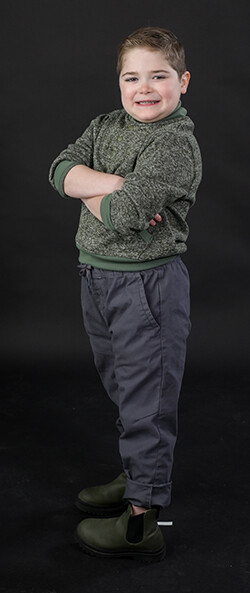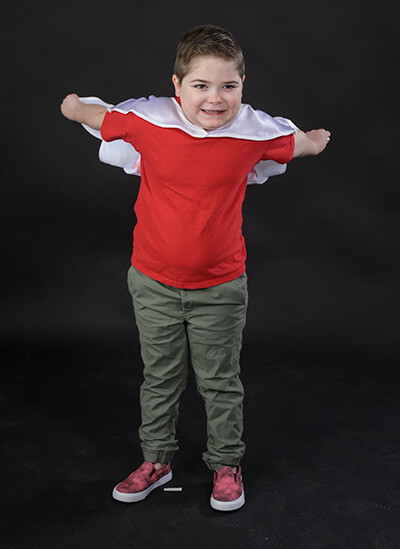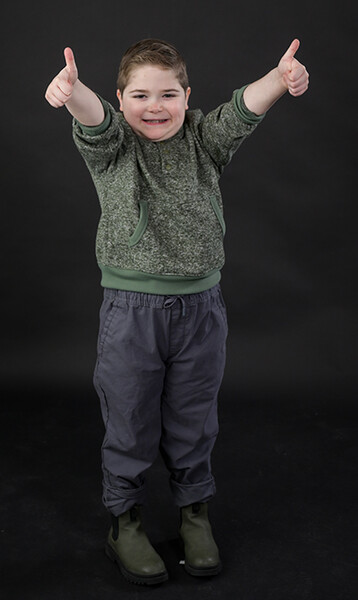
Ryder’s Amazing Recovery Continues With the Help of His Coordinated Care
DIAGNOSIS: RSV and post-infectious bronchiolitis obliterans (PIBO)

Ryder and his mom, Courtney, recently got back from his first trip to Disneyland. And while that might seem like a typical highlight of a typical childhood, Ryder’s path to the happiest place on earth was not an easy one.
Ryder, now 9, seemed like a healthy, robust baby. A bout of RSV (a common respiratory infection that can be life-threatening to babies) in infancy landed him in Children’s Health℠ Plano hospital for a few days. But other than being susceptible to respiratory viruses, Ryder seemed to bounce back just fine.
Another bout with RSV at 16 months was a different story.
“His daycare called me at work and said ‘There’s something really wrong. He’s lethargic and just not himself’,” Courtney said.
At first, she and Ryder’s dad, Jeff, weren’t too concerned. After all, things had always turned out OK when they had taken their little boy to Children’s Health Plano in the past. This time, however, Ryder’s vital signs suddenly plummeted. His hospital room filled up with doctors and someone told Courtney she needed to wait outside.
The medical team inserted a tube so Ryder could breathe and told the family to get ready to be transported to the pediatric intensive care unit (ICU) at Children’s Health Dallas where Ryder could get the care he needed.
“It was so urgent they considered a CareFlight to get us there, but the ambulance showed up first,” Courtney recalled.
Things were touch and go that first week in the ICU – Ryder wasn’t responding to the typical treatments that might clear his lungs and help him breathe on his own. After trying a variety of treatments in the first few days, Ryder’s care team suggested something unusual: Sevoflurane. A medication typically used by anesthesiologists to put kids into a sleep-like state before surgery, sevoflurane also causes the large airways in the lungs to open and can make it easier to breathe.
The treatment was his last chance, but at the time, it hadn’t been used often in instances such as Ryder’s and not typically on a child as small as him.
“Despite everything, I felt a lot of hope,” Courtney said. “There was hope that he was going to be OK. Hope that it was going to work. And it was nice to hear from attendings, residents and nurses that they felt hopeful, too.”

A team of providers monitored Ryder – and the machine administering the sevoflurane – around the clock. Four long days later, he finally started to breathe on his own and the ICU team was able to remove the breathing tube.
But the extreme treatment had taken its toll. Initially, Ryder couldn’t talk or move on his own, and he wasn’t quite conscious. The neurologist who examined him told Courtney and Jeff she’d be back the next day and gently warned them that their little boy might never be the same.
“I told the doctors that I wasn’t leaving without the same kid that I came in with,” Courtney said.
By the time the neurologist returned 24 hours later, things had started to change.
“She did the knee reflexology test and Ryder’s leg moved,” Jeff said. “I don’t remember her name, but I do remember how excited she was. And that she had a little tear in the corner of her eye.”
Ryder continued to improve in the ICU at Children’s Health Dallas for a few days and then spent nearly a month at a nearby rehabilitation hospital for children where he recovered his strength and learned to walk and talk again.
“You could see how determined Ryder was to get better. And all the nurses and therapists made the experience fun,” Courtney said. “It was a heartwarming experience.”
“Everybody at school knows him and people just like to be around him,” Jeff said. “He used to call himself the king of Kindergarten when he was there.”

But his life-threatening lung infection – and the intensity of the treatments that saved him – are a constant presence in his life.
Today, Ryder lives with a rare, irreversible lung disease known as post infectious bronchiolitis obliterans (PIBO), which means that the small airways (bronchioles) in his lungs are inflamed and narrowed. PIBO can develop in young children after a severe lower respiratory tract infection and causes persistent coughing, wheezing and build-up of mucus in the lungs – symptoms that are similar to what people with cystic fibrosis endure. A common cold can land him in the hospital.
Luckily, Ryder has a team of specialists in pulmonology, endocrinology, hematology and neurology at Children’s Health, who collaborate as a team to provide him holistic care.
Children’s Health is committed to providing the best, most comprehensive pediatric healthcare for all children and families in North Texas and beyond.
As we continue to anticipate the growing needs of the pediatric population today and for decades to come, philanthropic support will ensure patients and families have the exceptional care, support and resources they need, now and into the future.
Ryder’s parents are partners in his care and their diligence is helping him live his best possible life. This means keeping tabs on four inhalers, several different daily medications, two nebulizer treatments and twice daily chest physical therapy sessions with a CPT vest. This inflatable vest attaches to a machine that vibrates it at a high frequency and loosens the mucus in Ryder’s lungs.
It also means holding the line on wearing masks in public – even while at Disneyland. Ryder also wears his to school, and his best friend wears one, too, in solidarity.
“They are probably the only two at school who still do,” Courtney said. “But a cold could land Ryder in the hospital and …”
“And that’s scary for my mom,” Ryder said, finishing her thought.
Against the odds, Ryder perseveres and wants to be like the rest of his peers. He plays video games like Minecraft or Roblox online with his friends, and his dad organized a small fantasy football league.
“I want to keep up with my friends. But they walk fast and it’s not humanly possible for me,” he said. “They try to slow down. But I’d rather keep up.”
Read more patient stories like Ryder's to learn how Children's Health makes life better for children.
Kids count on us. We count on you.
Give to support innovative research, lifesaving treatments and compassionate care.
Did you enjoy this story?
If you would like to receive an email when new stories like this one are posted to our website, please complete the form below. We won't share your information, and you can unsubscribe any time.

